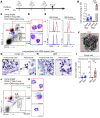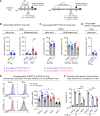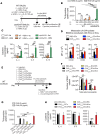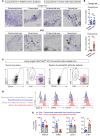Lung-resident eosinophils represent a distinct regulatory eosinophil subset
- PMID: 27548519
- PMCID: PMC5004964
- DOI: 10.1172/JCI85664
Lung-resident eosinophils represent a distinct regulatory eosinophil subset
Abstract
Increases in eosinophil numbers are associated with infection and allergic diseases, including asthma, but there is also evidence that eosinophils contribute to homeostatic immune processes. In mice, the normal lung contains resident eosinophils (rEos), but their function has not been characterized. Here, we have reported that steady-state pulmonary rEos are IL-5-independent parenchymal Siglec-FintCD62L+CD101lo cells with a ring-shaped nucleus. During house dust mite-induced airway allergy, rEos features remained unchanged, and rEos were accompanied by recruited inflammatory eosinophils (iEos), which were defined as IL-5-dependent peribronchial Siglec-FhiCD62L-CD101hi cells with a segmented nucleus. Gene expression analyses revealed a more regulatory profile for rEos than for iEos, and correspondingly, mice lacking lung rEos showed an increase in Th2 cell responses to inhaled allergens. Such elevation of Th2 responses was linked to the ability of rEos, but not iEos, to inhibit the maturation, and therefore the pro-Th2 function, of allergen-loaded DCs. Finally, we determined that the parenchymal rEos found in nonasthmatic human lungs (Siglec-8+CD62L+IL-3Rlo cells) were phenotypically distinct from the iEos isolated from the sputa of eosinophilic asthmatic patients (Siglec-8+CD62LloIL-3Rhi cells), suggesting that our findings in mice are relevant to humans. In conclusion, our data define lung rEos as a distinct eosinophil subset with key homeostatic functions.
Figures








Comment in
-
A hidden residential cell in the lung.J Clin Invest. 2016 Sep 1;126(9):3185-7. doi: 10.1172/JCI89768. Epub 2016 Aug 22. J Clin Invest. 2016. PMID: 27548525 Free PMC article.
References
Publication types
MeSH terms
Substances
LinkOut - more resources
Full Text Sources
Other Literature Sources
Medical
Molecular Biology Databases

